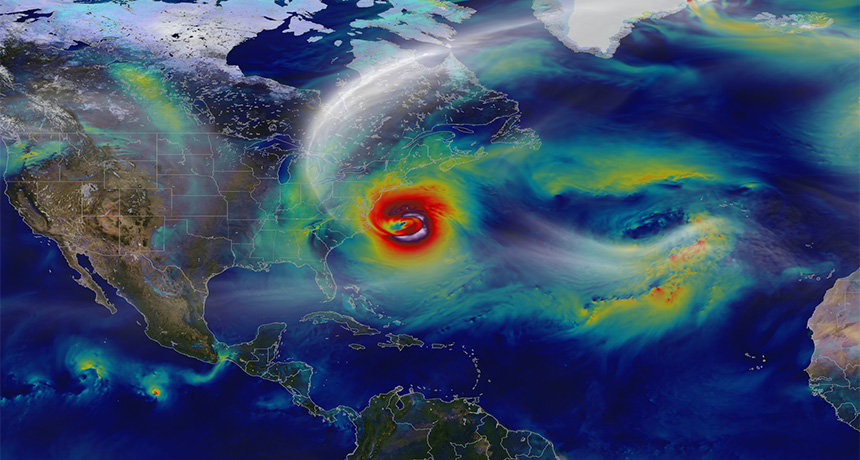Hurricane’s tiny earthquakes could help forecasters
Data on Sandy show temblors emanate from eye of storm

SEISMIC STORM Hurricane Sandy (visualized above) triggered tiny tremors under its eye as it stormed up the U.S. East Coast in 2012. These tiny quakes could help meteorologists closely monitor the behavior of raging hurricanes, researchers propose.
NASA
- More than 2 years ago
As Sandy raged, the ground trembled.
Rumbles picked up by seismometers during Hurricane Sandy’s trip up the U.S. East Coast in 2012 originated from the storm’s eye, seismologists report in a paper to be published in the Journal of Geophysical Research: Solid Earth. Listening for these rumbles could help meteorologists remotely monitor air pressure changes inside hurricanes and better predict sudden increases in storm intensity, the researchers propose.
“Seismology is opening up a new opportunity to look at things we’ve never seen before,” says Lianxing Wen, a seismologist at Stony Brook University in New York. “This seismicity could provide a supplementary way to look directly at the center of a hurricane system in real time.”
For decades, seismologists have heard the planet’s seismic soundscape get noisier when hurricanes roam. Unlike typical earthquakes, these extra tremors don’t create a clear signal, but rather add to the background noise. Indistinct shakes mean seismologists haven’t precisely determined where the quakes originate.
Before Hurricane Sandy shuffled up the East Coast in 2012, a project called Earthscope had deployed a temporary network of hundreds of seismometers throughout the eastern United States. The sheer number of monitors allowed Wen and seismologists Xiaohan Chen and Dongdong Tian of the University of Science and Technology of China in Hefei to pinpoint the exact source of the hurricane’s seismicity. If one seismic station hears a certain rumble that’s later picked up at another station some distance away, scientists can triangulate the shake’s source.
With 485 seismic stations available, the researchers ran through 117,370 different combinations of seismic sensors for each hour of data collected as Sandy approached Florida until just after it dissipated six days later (SN Online: 12/31/12). The researchers determined that the seismic signals originated from under Sandy’s eye.
Fluctuations in atmospheric pressure along the edge of the eye create ocean waves that reverberate down through the water and beat the seafloor like a drum, the scientists propose. These seafloor shakes are about as strong as a magnitude 1 earthquake, Wen says.
With a permanent seismic network, seismologists could listen for vibrations in real time and estimate the changes in atmospheric pressure responsible, Wen says. Meteorologists currently can’t measure such changes throughout the eye of the storm. That information could potentially help forecasters identify storms on the verge of intensifying, Wen adds.
While the new approach might be too simplified to provide useful information now, it provides a good starting point, says seismologist Toshiro Tanimoto of the University of California, Santa Barbara. “It’s amazing that hurricanes shake the ground, not just the air,” he says. “There has to be something we can learn from that.”
The new method definitely needs work, agrees Steve Garner, an atmospheric scientist at the National Oceanic and Atmospheric Administration’s Geophysical Fluid Dynamics Laboratory in Princeton, N.J. “I’ll be impressed if the method to detect changes in [the storm’s center] is reproducible,” he says.
Editor’s Note: This story was updated on September 8, 2015, to correct the name of the journal.






